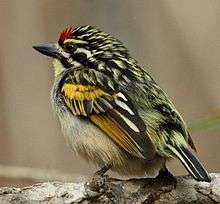Red-fronted tinkerbird
| Red-fronted tinkerbird | |
|---|---|
 | |
| Scientific classification | |
| Kingdom: | Animalia |
| Phylum: | Chordata |
| Class: | Aves |
| Order: | Piciformes |
| Family: | Lybiidae |
| Genus: | Pogoniulus |
| Species: | P. pusillus |
| Binomial name | |
| Pogoniulus pusillus (Dumont, 1816) | |
The red-fronted tinkerbird, Pogoniulus pusillus formerly known as the red-fronted tinker barbet is a small African barbet. Barbets are near passerine birds with bristles around the base of the bill. They have a world-wide tropical distribution.
The red-fronted tinkerbird is a widespread and frequently common resident breeder in eastern South Africa, with a separate population from southern Sudan and Ethiopia south to central and eastern Tanzania. It is sometimes considered conspecific with its northern counterpart, the yellow-fronted tinkerbird, Pogoniulus chrysoconus.
The red-fronted tinkerbird is associated with juniper forest and scrub. It nests in a tree hole and lays two or three eggs. It eats berries and fruit, particularly mistletoe, but also takes insects as it forages in deep cover.
The red-fronted tinkerbird is 9–10.5 cm (3.5–4.1 in) in length. It is a plump bird, with a short neck, large head, and short tail. The adult has black upperparts heavlly streaked with yellow and white, and a golden wing patch. Its head has a strong black and white pattern, with a red forecrown spot. Its underparts and rump are lemon yellow. Sexes are similar in appearance, but young birds lack the red forehead.
This species is distinguished from the yellow-fronted tinkerbird by the colour of the forehead spot, the golden wing patch, and its overall darker appearance. It is often confused with the red-fronted barbet, but it is significantly smaller than that species, has a black moustache and a less robust bill, and lacks a broad yellow superciliary stripe.
At about 100 repetitions per minute, the red-fronted tinkerbird's call is a fast tink-tink-tink-tink, very similar to that of the yellow-fronted tinkerbird. Many barbets perch prominently, but unlike their larger relatives, the smaller tinkerbirds sing from cover and are more frequently heard than seen.
References
- ↑ BirdLife International (2012). "Pogoniulus pusillus". IUCN Red List of Threatened Species. Version 2013.2. International Union for Conservation of Nature. Retrieved 26 November 2013.
- Sinclair, Hockey and Tarboton, SASOL Birds of Southern Africa, ISBN 1-86872-721-1
External links
- Red-fronted tinkerbird - Species text in The Atlas of Southern African Birds
- Kenya birds
